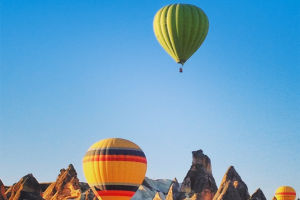
Before setting off on any hiking adventure, choosing the right gear is crucial.
Having the proper equipment ensures comfort, safety, and a smooth journey. So, let's dive into the essentials that every hiker should consider when preparing for an outdoor activity!
Clothing Essentials
First things first, let's talk about clothing. Whether you're trekking through mountains or hiking along a scenic trail, the right clothes can make all the difference.
1. Windproof and Waterproof Jacket & Pants: These are must-haves for outdoor activities. You'll need something durable, breathable, and weather-resistant to protect yourself from the elements.
2. Fleece Jacket: Perfect for keeping warm during chilly nights or early mornings, and it's easy to pack!
3. Moisture-Wicking Underwear: These help keep your body dry, especially during physical activities.
4. Quick-Dry Clothes: Ideal for summer hikes. It's also handy if the weather changes. Look for pants and sleeves that can be zipped off to adjust to your needs.
5. Down Jacket & Pants: A winter essential, especially for colder environments or high-altitude hikes.
6. Other Personal Clothes: Don't forget the basics—underwear, t-shirts, and socks. Lightweight, breathable items are best!
Footwear and Socks
Your feet are your primary means of transportation in hiking, so taking care of them is crucial.
1. Hiking Boots: Look for shoes that are durable, water-resistant, and provide ankle support. This will help avoid injury during tough hikes.
2. Casual Outdoor Shoes: For short, easy hikes or just casual outings, lightweight shoes will do the job.
3. Sports Sandals or Water Shoes: These are perfect for creek crossing or when you need a break from your hiking boots.
4. Moisture-Wicking Socks: A good pair of socks can prevent blisters and keep your feet dry, especially on long trails.
5. Normal Sports Socks: Cotton socks are comfortable, but make sure they're breathable to prevent any discomfort.
6. Gaiters: These come in handy in snow or muddy trails. They help protect your boots and lower legs.
Accessories for Protection
Accidents can happen, and it's essential to be prepared. Here are some accessories that will ensure you're ready for anything.
1. Sun Hat: A wide-brimmed hat will protect your face and neck from harmful UV rays.
2. Fleece Hat: For those colder moments, a warm hat can make all the difference.
3. Light Gloves: Ideal for taking photos, these gloves provide just enough warmth while keeping your hands agile.
4. Thicker Gloves: Necessary for colder conditions, especially in high altitudes.
5. Sunglasses: Protect your eyes from UV rays and harsh sunlight.
Backpack Essentials
Packing the right backpack is a game changer, as it keeps your gear organized and easy to carry.
1. Large Backpack: A must-have for longer trips. Choose one that's comfortable, with plenty of room (45-80L). A good balance between capacity and comfort is key.
2. Small Backpack: For shorter trips or as a daypack for the essentials, go for one between 15-30L.
3. Waist or Shoulder Bag: For keeping small items handy, a waist bag is super convenient.
4. Camera Bag: If you plan on capturing stunning views, having a separate bag for your camera gear can keep everything safe.
Camping Gear
If you're planning on camping during your hike, here are the essentials you shouldn't skip.
1. Sleeping Bag: A lightweight, compact sleeping bag is key for longer trips. Choose one that suits the season and weather conditions.
2. Sleeping Bag Liner: A liner adds comfort and warmth and keeps your bag clean.
3. Tent: Go for a waterproof, sturdy tent. Look for lightweight options if you're traveling long distances.
4. Sleeping Pad: Whether it's an inflatable one or a foam pad, a good sleeping pad will give you the comfort you need during camping.
5. Aluminum Foil Sheet: Lightweight and easy to pack, this can also double as a picnic mat.
Lighting Gear
When darkness falls, proper lighting becomes a necessity.
1. Headlamp: Hands-free lighting is perfect for when you're setting up camp or navigating dark trails.
2. Flashlight: A backup light source just in case your headlamp fails.
3. Camp Lantern: Great for brightening up your campsite or tent.
4. Waterproof Matches & Windproof Lighter: In case of an emergency, these are handy for lighting your campfire.
Cooking Gear
Eating hot food in the wild feels like a luxury, and these tools will help you enjoy that luxury.
1. Stove: A reliable stove will make cooking in the wild easier.
2. Fuel Canister: Don't forget to bring enough fuel for your stove!
3. Cookware: A small pot or pan will come in handy for everything from boiling water to frying up your meal.
4. Steel Cup: Lightweight and durable, it's perfect for both drinking and cooking.
5. Grill: If you're into BBQ, bring a portable grill for some outdoor cooking.
Water Gear
Staying hydrated is vital. Here's how to keep your water safe and easily accessible.
1. Water Bottle: Durable and easy to carry, a good water bottle can keep your drink safe and cool.
2. Hydration Bladder: Ideal for long hikes, this makes sipping on the go super convenient.
3. Insulated Water Bottle: Perfect for winter trips. You'll love sipping on hot drinks while on the move.
Communication Gear
Staying connected is crucial when you're out in the wilderness.
1. Phone: Your phone is your primary connection to the outside world, but remember, it might not have signal in remote areas.
2. Walkie-Talkie: If you're hiking with a group, walkie-talkies are perfect for communication.
3. GPS: An essential for navigation, especially in remote areas where trails can be hard to find.
4. Survival Whistle: A small but powerful tool that could be a lifesaver in an emergency.
Other Essentials
Some items are small but make a big difference in your comfort and safety.
1. Trekking Poles: These will help save energy and provide stability on uneven terrain.
2. Toiletries: Pack the basics—soap, toothpaste, toilet paper, and any personal hygiene items you might need.
3. Rain Cover for Backpack: Keep your gear dry in case of rain. It's a lifesaver for your backpack.
4. Map: Never underestimate the power of a good map, especially in unfamiliar terrain.
5. Multi-tool: A multi-tool is incredibly useful for all sorts of situations.
When Buying Outdoor Gear
Choosing outdoor gear can be overwhelming, but these tips can guide you.
1. Buy Based on Activity Needs: Only buy what's necessary for the activities you'll be doing often.
2. Prioritize Essentials: Safety and comfort come first—don't waste money on non-essential gear.
3. Multi-Function Gear: Choose gear that can serve multiple purposes to save space and money.
4. Consider Value: Test out products in-store and compare prices online to find the best deals.
5. Safety Over Price: For safety equipment, always choose quality over the lowest price. It's worth investing in your safety.
Now, Lykkers, you're all set to take on your next hiking adventure. Make sure to pack well, stay safe, and most importantly, have fun out there!


